Tourism Crisis Management Toolkit: Analysis of Global Crises
VerifiedAdded on 2022/08/24
|19
|4333
|16
Homework Assignment
AI Summary
This assignment, titled "Tourism Crisis Management Toolkit," delves into the complexities of crisis management within the global tourism industry. The student begins by defining the concept of a crisis through triangulation, drawing upon multiple sources to create a working definition. The assignment then analyzes the impact of various crises, such as hurricanes and health epidemics, on tourism in specific destinations like the Caribbean and West Africa, examining pre- and post-crisis arrival figures. Furthermore, the student assesses potential tourism crises, focusing on water scarcity, and discusses its global implications, including a case study of Mauritius. The assignment concludes with an analysis of risk management strategies, identifying potential risks and hazards facing the Icelandic tourism industry, evaluating their likelihood and severity, and justifying the most significant threat: overtourism.
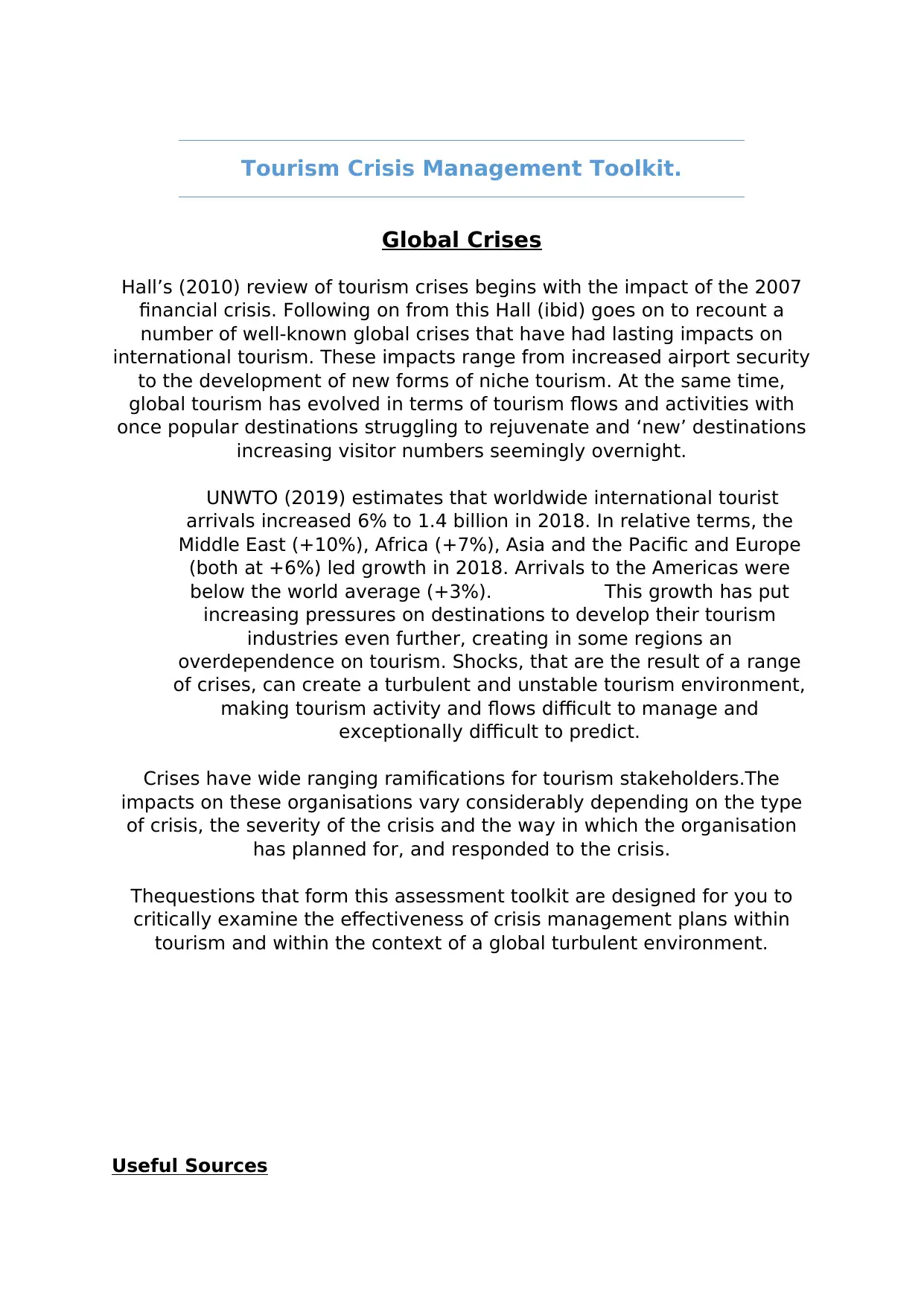
Tourism Crisis Management Toolkit.
Global Crises
Hall’s (2010) review of tourism crises begins with the impact of the 2007
financial crisis. Following on from this Hall (ibid) goes on to recount a
number of well-known global crises that have had lasting impacts on
international tourism. These impacts range from increased airport security
to the development of new forms of niche tourism. At the same time,
global tourism has evolved in terms of tourism flows and activities with
once popular destinations struggling to rejuvenate and ‘new’ destinations
increasing visitor numbers seemingly overnight.
UNWTO (2019) estimates that worldwide international tourist
arrivals increased 6% to 1.4 billion in 2018. In relative terms, the
Middle East (+10%), Africa (+7%), Asia and the Pacific and Europe
(both at +6%) led growth in 2018. Arrivals to the Americas were
below the world average (+3%). This growth has put
increasing pressures on destinations to develop their tourism
industries even further, creating in some regions an
overdependence on tourism. Shocks, that are the result of a range
of crises, can create a turbulent and unstable tourism environment,
making tourism activity and flows difficult to manage and
exceptionally difficult to predict.
Crises have wide ranging ramifications for tourism stakeholders.The
impacts on these organisations vary considerably depending on the type
of crisis, the severity of the crisis and the way in which the organisation
has planned for, and responded to the crisis.
Thequestions that form this assessment toolkit are designed for you to
critically examine the effectiveness of crisis management plans within
tourism and within the context of a global turbulent environment.
Useful Sources
Global Crises
Hall’s (2010) review of tourism crises begins with the impact of the 2007
financial crisis. Following on from this Hall (ibid) goes on to recount a
number of well-known global crises that have had lasting impacts on
international tourism. These impacts range from increased airport security
to the development of new forms of niche tourism. At the same time,
global tourism has evolved in terms of tourism flows and activities with
once popular destinations struggling to rejuvenate and ‘new’ destinations
increasing visitor numbers seemingly overnight.
UNWTO (2019) estimates that worldwide international tourist
arrivals increased 6% to 1.4 billion in 2018. In relative terms, the
Middle East (+10%), Africa (+7%), Asia and the Pacific and Europe
(both at +6%) led growth in 2018. Arrivals to the Americas were
below the world average (+3%). This growth has put
increasing pressures on destinations to develop their tourism
industries even further, creating in some regions an
overdependence on tourism. Shocks, that are the result of a range
of crises, can create a turbulent and unstable tourism environment,
making tourism activity and flows difficult to manage and
exceptionally difficult to predict.
Crises have wide ranging ramifications for tourism stakeholders.The
impacts on these organisations vary considerably depending on the type
of crisis, the severity of the crisis and the way in which the organisation
has planned for, and responded to the crisis.
Thequestions that form this assessment toolkit are designed for you to
critically examine the effectiveness of crisis management plans within
tourism and within the context of a global turbulent environment.
Useful Sources
Paraphrase This Document
Need a fresh take? Get an instant paraphrase of this document with our AI Paraphraser
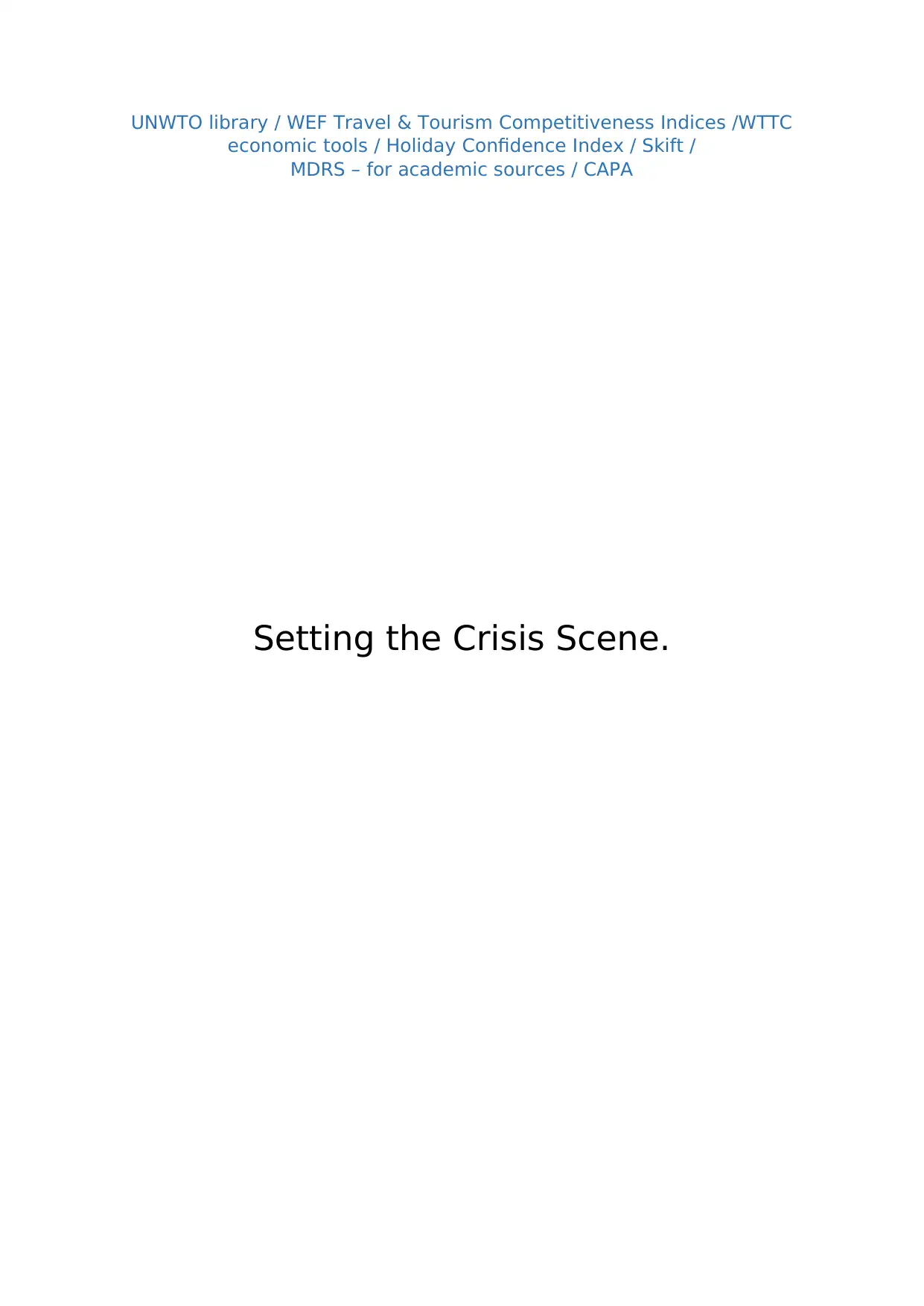
UNWTO library / WEF Travel & Tourism Competitiveness Indices /WTTC
economic tools / Holiday Confidence Index / Skift /
MDRS – for academic sources / CAPA
Setting the Crisis Scene.
economic tools / Holiday Confidence Index / Skift /
MDRS – for academic sources / CAPA
Setting the Crisis Scene.
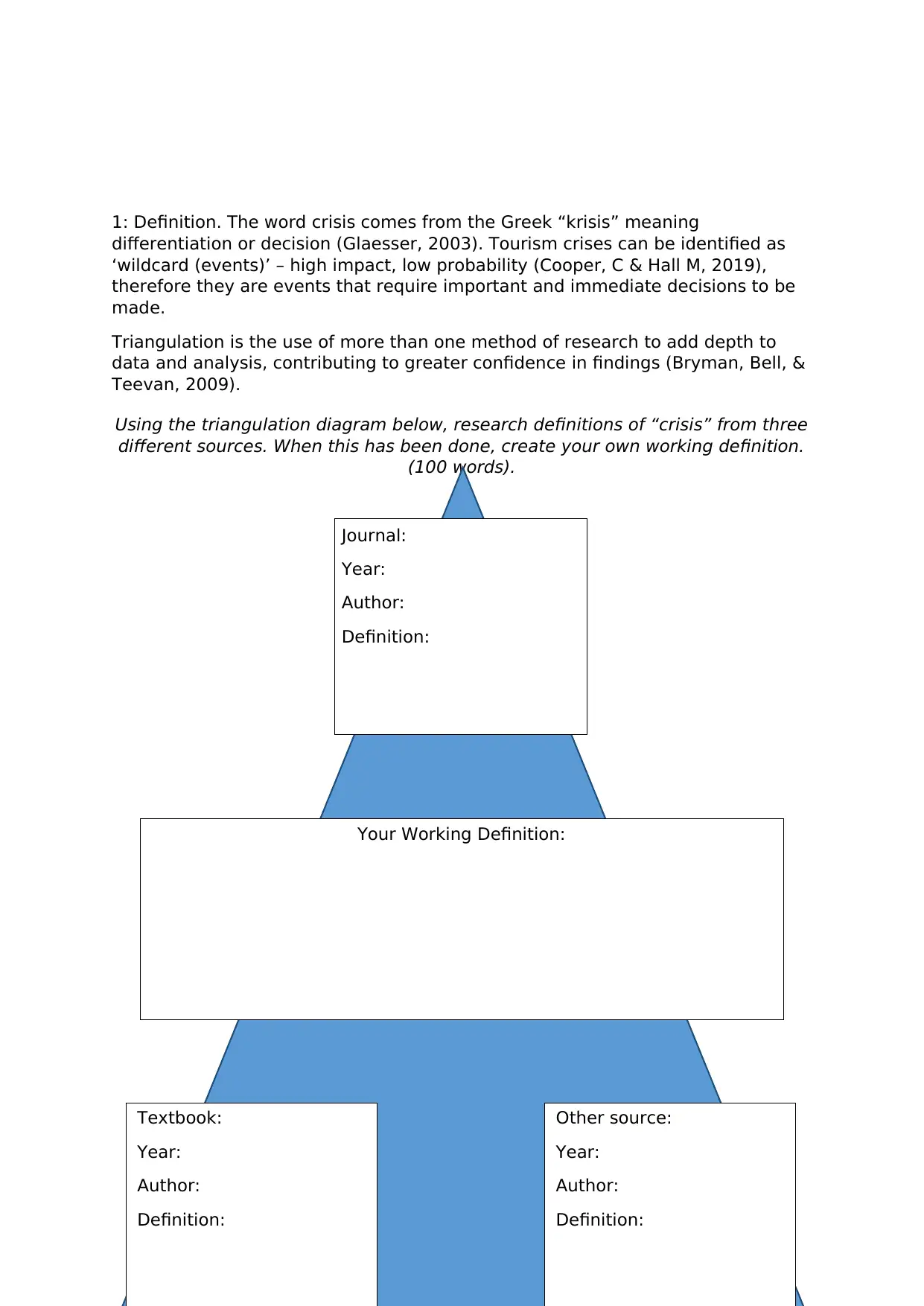
1: Definition. The word crisis comes from the Greek “krisis” meaning
differentiation or decision (Glaesser, 2003). Tourism crises can be identified as
‘wildcard (events)’ – high impact, low probability (Cooper, C & Hall M, 2019),
therefore they are events that require important and immediate decisions to be
made.
Triangulation is the use of more than one method of research to add depth to
data and analysis, contributing to greater confidence in findings (Bryman, Bell, &
Teevan, 2009).
Using the triangulation diagram below, research definitions of “crisis” from three
different sources. When this has been done, create your own working definition.
(100 words).
Journal:
Year:
Author:
Definition:
Textbook:
Year:
Author:
Definition:
Other source:
Year:
Author:
Definition:
Your Working Definition:
differentiation or decision (Glaesser, 2003). Tourism crises can be identified as
‘wildcard (events)’ – high impact, low probability (Cooper, C & Hall M, 2019),
therefore they are events that require important and immediate decisions to be
made.
Triangulation is the use of more than one method of research to add depth to
data and analysis, contributing to greater confidence in findings (Bryman, Bell, &
Teevan, 2009).
Using the triangulation diagram below, research definitions of “crisis” from three
different sources. When this has been done, create your own working definition.
(100 words).
Journal:
Year:
Author:
Definition:
Textbook:
Year:
Author:
Definition:
Other source:
Year:
Author:
Definition:
Your Working Definition:
⊘ This is a preview!⊘
Do you want full access?
Subscribe today to unlock all pages.

Trusted by 1+ million students worldwide
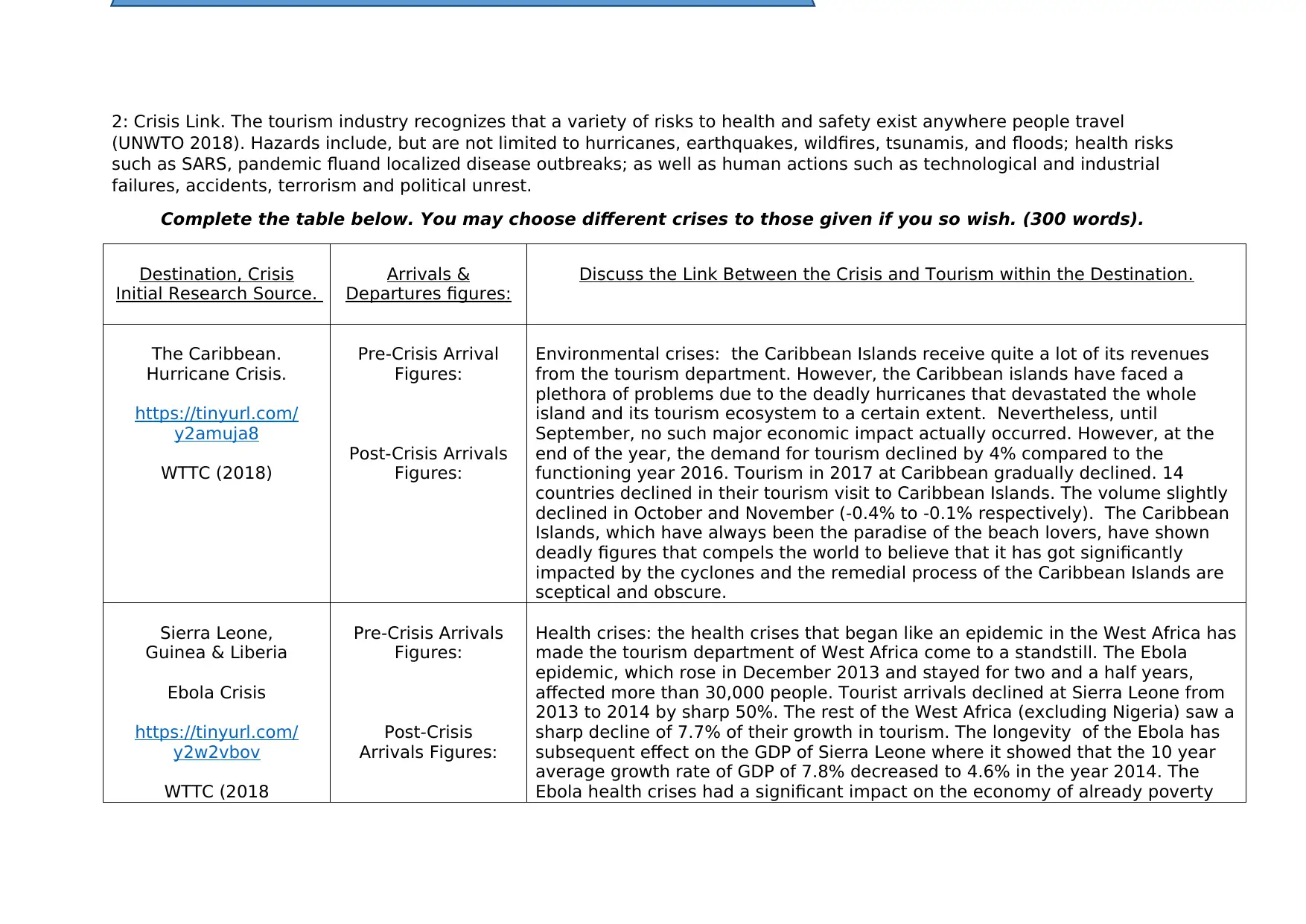
2: Crisis Link. The tourism industry recognizes that a variety of risks to health and safety exist anywhere people travel
(UNWTO 2018). Hazards include, but are not limited to hurricanes, earthquakes, wildfires, tsunamis, and floods; health risks
such as SARS, pandemic fluand localized disease outbreaks; as well as human actions such as technological and industrial
failures, accidents, terrorism and political unrest.
Complete the table below. You may choose different crises to those given if you so wish. (300 words).
Destination, Crisis
Initial Research Source.
Arrivals &
Departures figures:
Discuss the Link Between the Crisis and Tourism within the Destination.
The Caribbean.
Hurricane Crisis.
https://tinyurl.com/
y2amuja8
WTTC (2018)
Pre-Crisis Arrival
Figures:
Post-Crisis Arrivals
Figures:
Environmental crises: the Caribbean Islands receive quite a lot of its revenues
from the tourism department. However, the Caribbean islands have faced a
plethora of problems due to the deadly hurricanes that devastated the whole
island and its tourism ecosystem to a certain extent. Nevertheless, until
September, no such major economic impact actually occurred. However, at the
end of the year, the demand for tourism declined by 4% compared to the
functioning year 2016. Tourism in 2017 at Caribbean gradually declined. 14
countries declined in their tourism visit to Caribbean Islands. The volume slightly
declined in October and November (-0.4% to -0.1% respectively). The Caribbean
Islands, which have always been the paradise of the beach lovers, have shown
deadly figures that compels the world to believe that it has got significantly
impacted by the cyclones and the remedial process of the Caribbean Islands are
sceptical and obscure.
Sierra Leone,
Guinea & Liberia
Ebola Crisis
https://tinyurl.com/
y2w2vbov
WTTC (2018
Pre-Crisis Arrivals
Figures:
Post-Crisis
Arrivals Figures:
Health crises: the health crises that began like an epidemic in the West Africa has
made the tourism department of West Africa come to a standstill. The Ebola
epidemic, which rose in December 2013 and stayed for two and a half years,
affected more than 30,000 people. Tourist arrivals declined at Sierra Leone from
2013 to 2014 by sharp 50%. The rest of the West Africa (excluding Nigeria) saw a
sharp decline of 7.7% of their growth in tourism. The longevity of the Ebola has
subsequent effect on the GDP of Sierra Leone where it showed that the 10 year
average growth rate of GDP of 7.8% decreased to 4.6% in the year 2014. The
Ebola health crises had a significant impact on the economy of already poverty
(UNWTO 2018). Hazards include, but are not limited to hurricanes, earthquakes, wildfires, tsunamis, and floods; health risks
such as SARS, pandemic fluand localized disease outbreaks; as well as human actions such as technological and industrial
failures, accidents, terrorism and political unrest.
Complete the table below. You may choose different crises to those given if you so wish. (300 words).
Destination, Crisis
Initial Research Source.
Arrivals &
Departures figures:
Discuss the Link Between the Crisis and Tourism within the Destination.
The Caribbean.
Hurricane Crisis.
https://tinyurl.com/
y2amuja8
WTTC (2018)
Pre-Crisis Arrival
Figures:
Post-Crisis Arrivals
Figures:
Environmental crises: the Caribbean Islands receive quite a lot of its revenues
from the tourism department. However, the Caribbean islands have faced a
plethora of problems due to the deadly hurricanes that devastated the whole
island and its tourism ecosystem to a certain extent. Nevertheless, until
September, no such major economic impact actually occurred. However, at the
end of the year, the demand for tourism declined by 4% compared to the
functioning year 2016. Tourism in 2017 at Caribbean gradually declined. 14
countries declined in their tourism visit to Caribbean Islands. The volume slightly
declined in October and November (-0.4% to -0.1% respectively). The Caribbean
Islands, which have always been the paradise of the beach lovers, have shown
deadly figures that compels the world to believe that it has got significantly
impacted by the cyclones and the remedial process of the Caribbean Islands are
sceptical and obscure.
Sierra Leone,
Guinea & Liberia
Ebola Crisis
https://tinyurl.com/
y2w2vbov
WTTC (2018
Pre-Crisis Arrivals
Figures:
Post-Crisis
Arrivals Figures:
Health crises: the health crises that began like an epidemic in the West Africa has
made the tourism department of West Africa come to a standstill. The Ebola
epidemic, which rose in December 2013 and stayed for two and a half years,
affected more than 30,000 people. Tourist arrivals declined at Sierra Leone from
2013 to 2014 by sharp 50%. The rest of the West Africa (excluding Nigeria) saw a
sharp decline of 7.7% of their growth in tourism. The longevity of the Ebola has
subsequent effect on the GDP of Sierra Leone where it showed that the 10 year
average growth rate of GDP of 7.8% decreased to 4.6% in the year 2014. The
Ebola health crises had a significant impact on the economy of already poverty
Paraphrase This Document
Need a fresh take? Get an instant paraphrase of this document with our AI Paraphraser
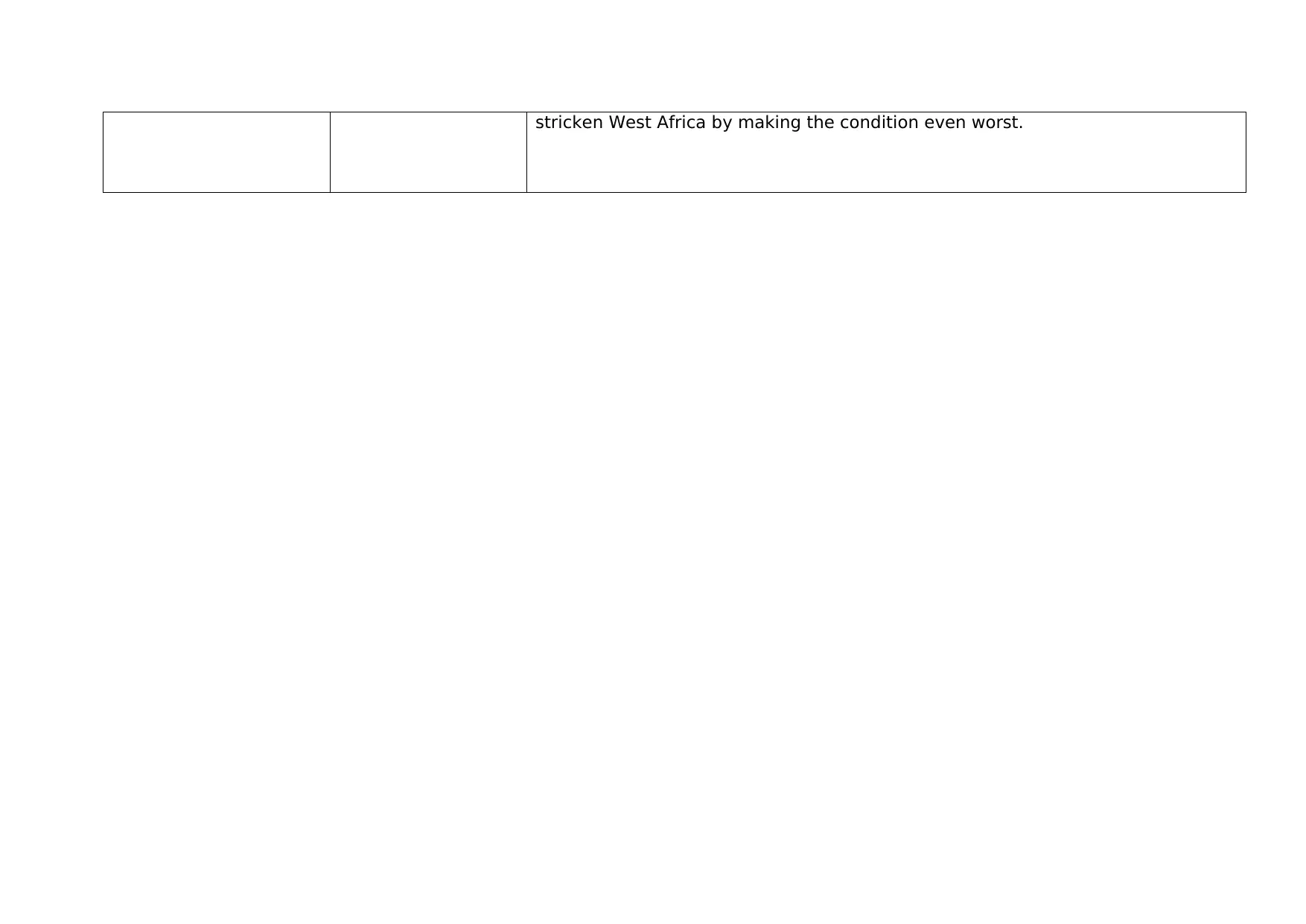
stricken West Africa by making the condition even worst.
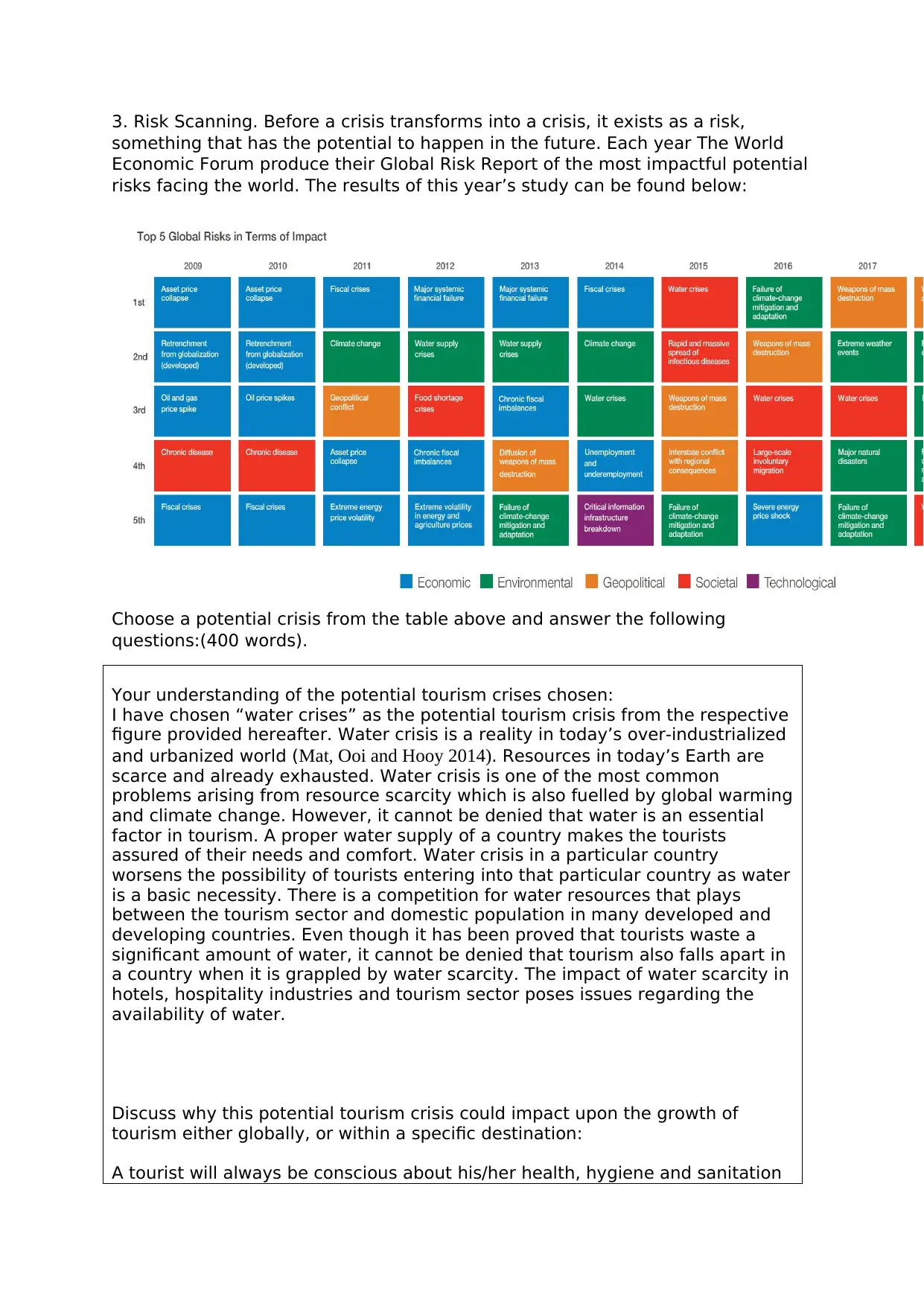
3. Risk Scanning. Before a crisis transforms into a crisis, it exists as a risk,
something that has the potential to happen in the future. Each year The World
Economic Forum produce their Global Risk Report of the most impactful potential
risks facing the world. The results of this year’s study can be found below:
Choose a potential crisis from the table above and answer the following
questions:(400 words).
Your understanding of the potential tourism crises chosen:
I have chosen “water crises” as the potential tourism crisis from the respective
figure provided hereafter. Water crisis is a reality in today’s over-industrialized
and urbanized world (Mat, Ooi and Hooy 2014). Resources in today’s Earth are
scarce and already exhausted. Water crisis is one of the most common
problems arising from resource scarcity which is also fuelled by global warming
and climate change. However, it cannot be denied that water is an essential
factor in tourism. A proper water supply of a country makes the tourists
assured of their needs and comfort. Water crisis in a particular country
worsens the possibility of tourists entering into that particular country as water
is a basic necessity. There is a competition for water resources that plays
between the tourism sector and domestic population in many developed and
developing countries. Even though it has been proved that tourists waste a
significant amount of water, it cannot be denied that tourism also falls apart in
a country when it is grappled by water scarcity. The impact of water scarcity in
hotels, hospitality industries and tourism sector poses issues regarding the
availability of water.
Discuss why this potential tourism crisis could impact upon the growth of
tourism either globally, or within a specific destination:
A tourist will always be conscious about his/her health, hygiene and sanitation
something that has the potential to happen in the future. Each year The World
Economic Forum produce their Global Risk Report of the most impactful potential
risks facing the world. The results of this year’s study can be found below:
Choose a potential crisis from the table above and answer the following
questions:(400 words).
Your understanding of the potential tourism crises chosen:
I have chosen “water crises” as the potential tourism crisis from the respective
figure provided hereafter. Water crisis is a reality in today’s over-industrialized
and urbanized world (Mat, Ooi and Hooy 2014). Resources in today’s Earth are
scarce and already exhausted. Water crisis is one of the most common
problems arising from resource scarcity which is also fuelled by global warming
and climate change. However, it cannot be denied that water is an essential
factor in tourism. A proper water supply of a country makes the tourists
assured of their needs and comfort. Water crisis in a particular country
worsens the possibility of tourists entering into that particular country as water
is a basic necessity. There is a competition for water resources that plays
between the tourism sector and domestic population in many developed and
developing countries. Even though it has been proved that tourists waste a
significant amount of water, it cannot be denied that tourism also falls apart in
a country when it is grappled by water scarcity. The impact of water scarcity in
hotels, hospitality industries and tourism sector poses issues regarding the
availability of water.
Discuss why this potential tourism crisis could impact upon the growth of
tourism either globally, or within a specific destination:
A tourist will always be conscious about his/her health, hygiene and sanitation
⊘ This is a preview!⊘
Do you want full access?
Subscribe today to unlock all pages.

Trusted by 1+ million students worldwide
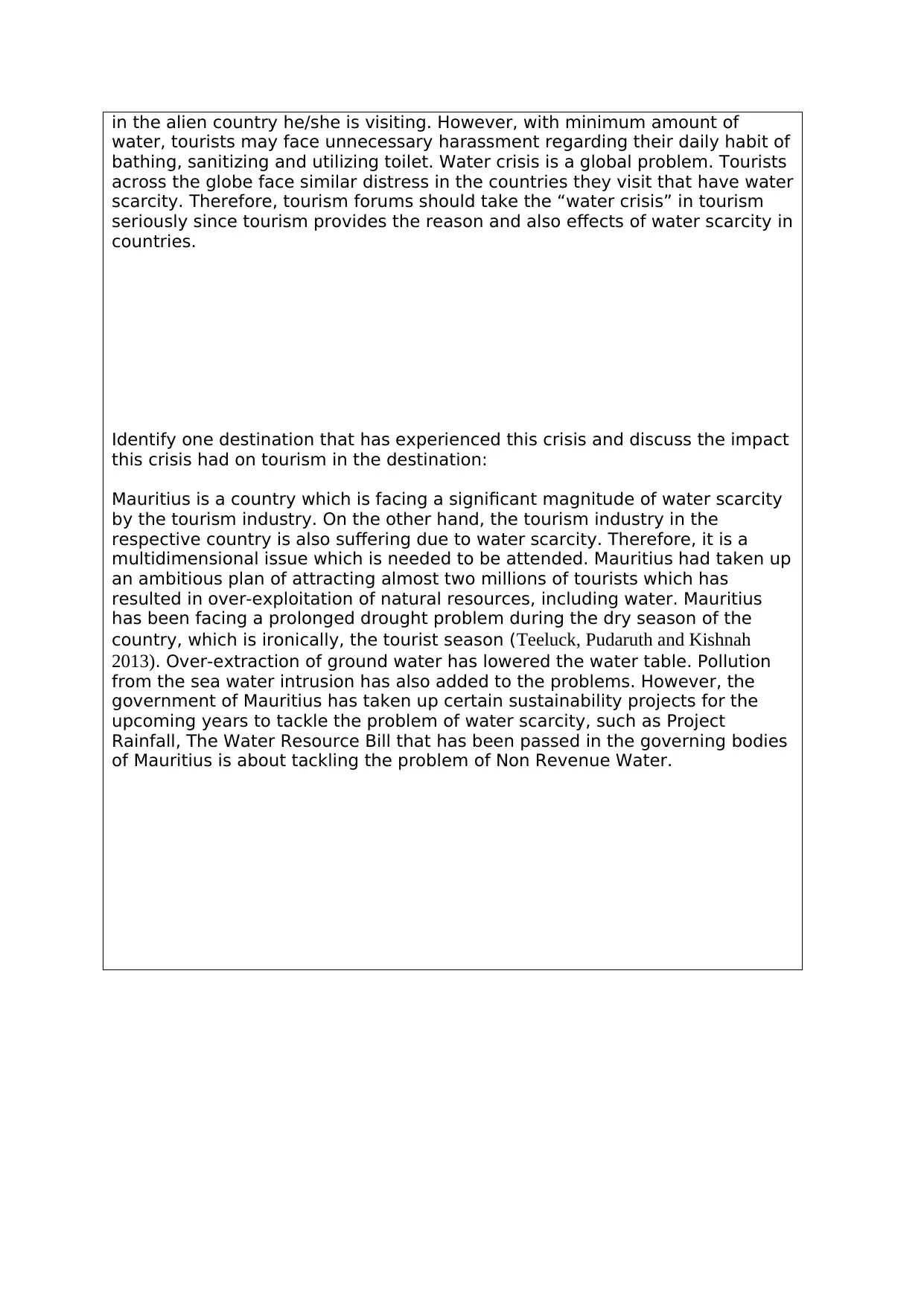
in the alien country he/she is visiting. However, with minimum amount of
water, tourists may face unnecessary harassment regarding their daily habit of
bathing, sanitizing and utilizing toilet. Water crisis is a global problem. Tourists
across the globe face similar distress in the countries they visit that have water
scarcity. Therefore, tourism forums should take the “water crisis” in tourism
seriously since tourism provides the reason and also effects of water scarcity in
countries.
Identify one destination that has experienced this crisis and discuss the impact
this crisis had on tourism in the destination:
Mauritius is a country which is facing a significant magnitude of water scarcity
by the tourism industry. On the other hand, the tourism industry in the
respective country is also suffering due to water scarcity. Therefore, it is a
multidimensional issue which is needed to be attended. Mauritius had taken up
an ambitious plan of attracting almost two millions of tourists which has
resulted in over-exploitation of natural resources, including water. Mauritius
has been facing a prolonged drought problem during the dry season of the
country, which is ironically, the tourist season (Teeluck, Pudaruth and Kishnah
2013). Over-extraction of ground water has lowered the water table. Pollution
from the sea water intrusion has also added to the problems. However, the
government of Mauritius has taken up certain sustainability projects for the
upcoming years to tackle the problem of water scarcity, such as Project
Rainfall, The Water Resource Bill that has been passed in the governing bodies
of Mauritius is about tackling the problem of Non Revenue Water.
water, tourists may face unnecessary harassment regarding their daily habit of
bathing, sanitizing and utilizing toilet. Water crisis is a global problem. Tourists
across the globe face similar distress in the countries they visit that have water
scarcity. Therefore, tourism forums should take the “water crisis” in tourism
seriously since tourism provides the reason and also effects of water scarcity in
countries.
Identify one destination that has experienced this crisis and discuss the impact
this crisis had on tourism in the destination:
Mauritius is a country which is facing a significant magnitude of water scarcity
by the tourism industry. On the other hand, the tourism industry in the
respective country is also suffering due to water scarcity. Therefore, it is a
multidimensional issue which is needed to be attended. Mauritius had taken up
an ambitious plan of attracting almost two millions of tourists which has
resulted in over-exploitation of natural resources, including water. Mauritius
has been facing a prolonged drought problem during the dry season of the
country, which is ironically, the tourist season (Teeluck, Pudaruth and Kishnah
2013). Over-extraction of ground water has lowered the water table. Pollution
from the sea water intrusion has also added to the problems. However, the
government of Mauritius has taken up certain sustainability projects for the
upcoming years to tackle the problem of water scarcity, such as Project
Rainfall, The Water Resource Bill that has been passed in the governing bodies
of Mauritius is about tackling the problem of Non Revenue Water.
Paraphrase This Document
Need a fresh take? Get an instant paraphrase of this document with our AI Paraphraser
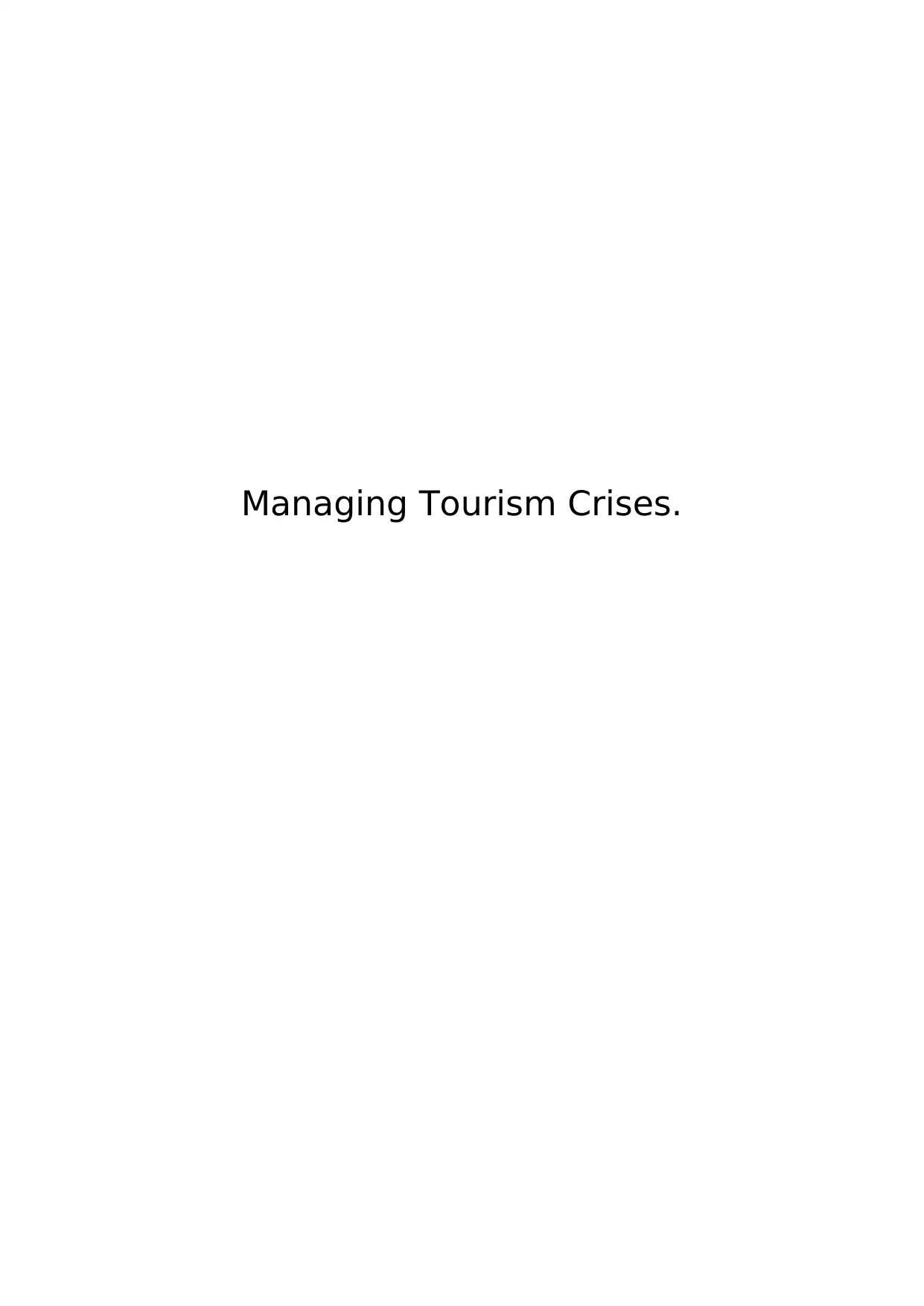
Managing Tourism Crises.
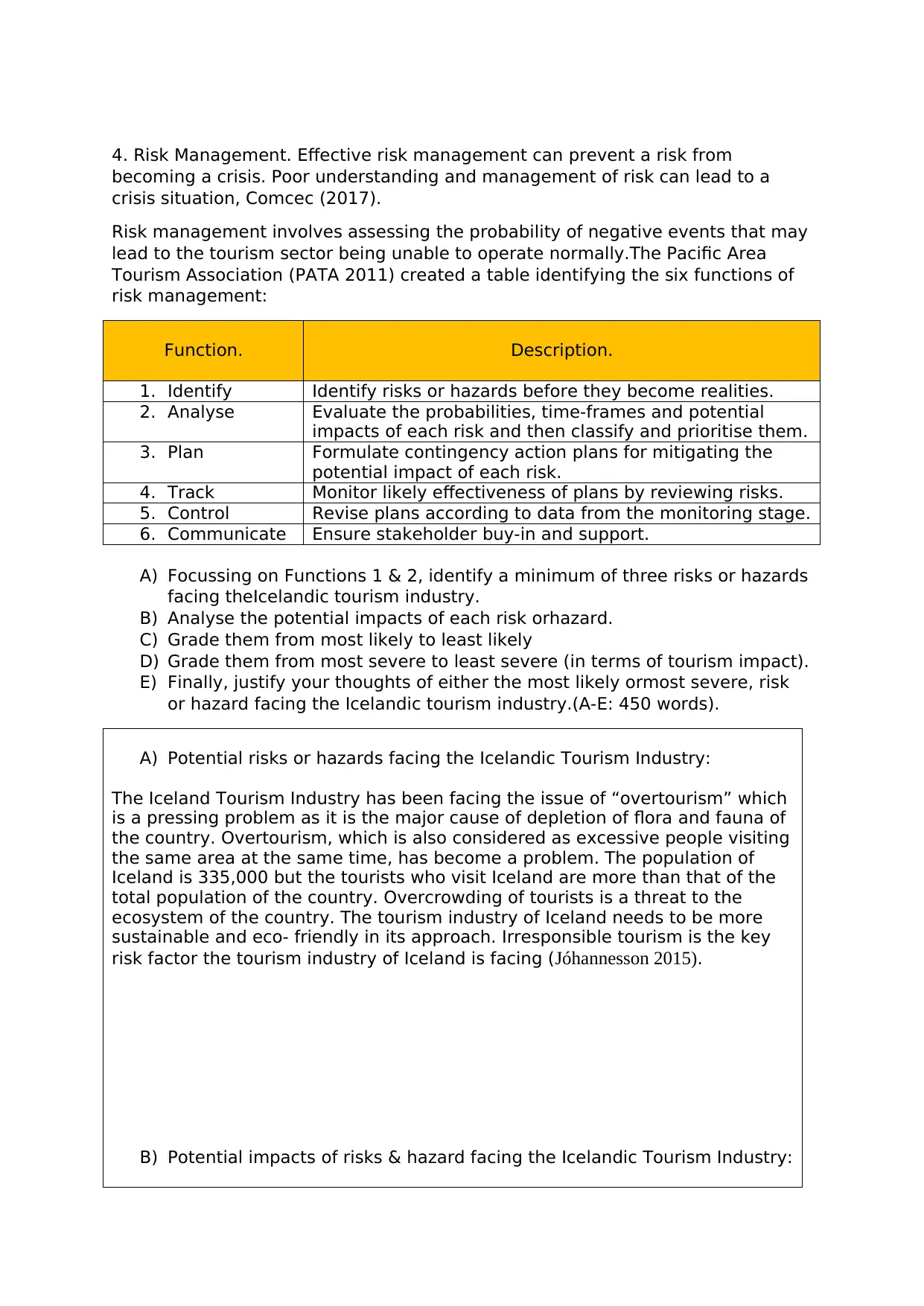
4. Risk Management. Effective risk management can prevent a risk from
becoming a crisis. Poor understanding and management of risk can lead to a
crisis situation, Comcec (2017).
Risk management involves assessing the probability of negative events that may
lead to the tourism sector being unable to operate normally.The Pacific Area
Tourism Association (PATA 2011) created a table identifying the six functions of
risk management:
Function. Description.
1. Identify Identify risks or hazards before they become realities.
2. Analyse Evaluate the probabilities, time-frames and potential
impacts of each risk and then classify and prioritise them.
3. Plan Formulate contingency action plans for mitigating the
potential impact of each risk.
4. Track Monitor likely effectiveness of plans by reviewing risks.
5. Control Revise plans according to data from the monitoring stage.
6. Communicate Ensure stakeholder buy-in and support.
A) Focussing on Functions 1 & 2, identify a minimum of three risks or hazards
facing theIcelandic tourism industry.
B) Analyse the potential impacts of each risk orhazard.
C) Grade them from most likely to least likely
D) Grade them from most severe to least severe (in terms of tourism impact).
E) Finally, justify your thoughts of either the most likely ormost severe, risk
or hazard facing the Icelandic tourism industry.(A-E: 450 words).
A) Potential risks or hazards facing the Icelandic Tourism Industry:
The Iceland Tourism Industry has been facing the issue of “overtourism” which
is a pressing problem as it is the major cause of depletion of flora and fauna of
the country. Overtourism, which is also considered as excessive people visiting
the same area at the same time, has become a problem. The population of
Iceland is 335,000 but the tourists who visit Iceland are more than that of the
total population of the country. Overcrowding of tourists is a threat to the
ecosystem of the country. The tourism industry of Iceland needs to be more
sustainable and eco- friendly in its approach. Irresponsible tourism is the key
risk factor the tourism industry of Iceland is facing (Jóhannesson 2015).
B) Potential impacts of risks & hazard facing the Icelandic Tourism Industry:
becoming a crisis. Poor understanding and management of risk can lead to a
crisis situation, Comcec (2017).
Risk management involves assessing the probability of negative events that may
lead to the tourism sector being unable to operate normally.The Pacific Area
Tourism Association (PATA 2011) created a table identifying the six functions of
risk management:
Function. Description.
1. Identify Identify risks or hazards before they become realities.
2. Analyse Evaluate the probabilities, time-frames and potential
impacts of each risk and then classify and prioritise them.
3. Plan Formulate contingency action plans for mitigating the
potential impact of each risk.
4. Track Monitor likely effectiveness of plans by reviewing risks.
5. Control Revise plans according to data from the monitoring stage.
6. Communicate Ensure stakeholder buy-in and support.
A) Focussing on Functions 1 & 2, identify a minimum of three risks or hazards
facing theIcelandic tourism industry.
B) Analyse the potential impacts of each risk orhazard.
C) Grade them from most likely to least likely
D) Grade them from most severe to least severe (in terms of tourism impact).
E) Finally, justify your thoughts of either the most likely ormost severe, risk
or hazard facing the Icelandic tourism industry.(A-E: 450 words).
A) Potential risks or hazards facing the Icelandic Tourism Industry:
The Iceland Tourism Industry has been facing the issue of “overtourism” which
is a pressing problem as it is the major cause of depletion of flora and fauna of
the country. Overtourism, which is also considered as excessive people visiting
the same area at the same time, has become a problem. The population of
Iceland is 335,000 but the tourists who visit Iceland are more than that of the
total population of the country. Overcrowding of tourists is a threat to the
ecosystem of the country. The tourism industry of Iceland needs to be more
sustainable and eco- friendly in its approach. Irresponsible tourism is the key
risk factor the tourism industry of Iceland is facing (Jóhannesson 2015).
B) Potential impacts of risks & hazard facing the Icelandic Tourism Industry:
⊘ This is a preview!⊘
Do you want full access?
Subscribe today to unlock all pages.

Trusted by 1+ million students worldwide
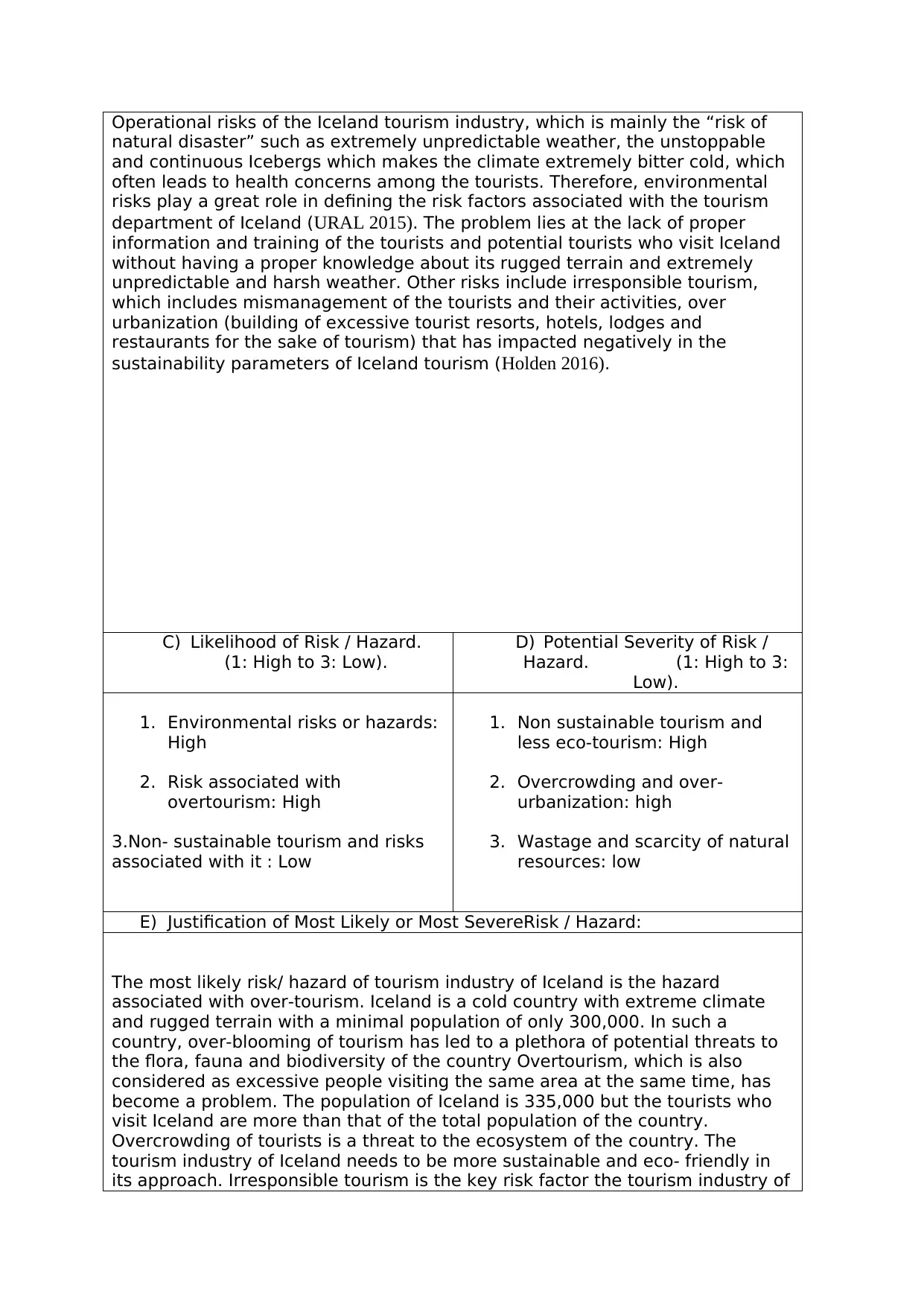
Operational risks of the Iceland tourism industry, which is mainly the “risk of
natural disaster” such as extremely unpredictable weather, the unstoppable
and continuous Icebergs which makes the climate extremely bitter cold, which
often leads to health concerns among the tourists. Therefore, environmental
risks play a great role in defining the risk factors associated with the tourism
department of Iceland (URAL 2015). The problem lies at the lack of proper
information and training of the tourists and potential tourists who visit Iceland
without having a proper knowledge about its rugged terrain and extremely
unpredictable and harsh weather. Other risks include irresponsible tourism,
which includes mismanagement of the tourists and their activities, over
urbanization (building of excessive tourist resorts, hotels, lodges and
restaurants for the sake of tourism) that has impacted negatively in the
sustainability parameters of Iceland tourism (Holden 2016).
C) Likelihood of Risk / Hazard.
(1: High to 3: Low).
D) Potential Severity of Risk /
Hazard. (1: High to 3:
Low).
1. Environmental risks or hazards:
High
2. Risk associated with
overtourism: High
3.Non- sustainable tourism and risks
associated with it : Low
1. Non sustainable tourism and
less eco-tourism: High
2. Overcrowding and over-
urbanization: high
3. Wastage and scarcity of natural
resources: low
E) Justification of Most Likely or Most SevereRisk / Hazard:
The most likely risk/ hazard of tourism industry of Iceland is the hazard
associated with over-tourism. Iceland is a cold country with extreme climate
and rugged terrain with a minimal population of only 300,000. In such a
country, over-blooming of tourism has led to a plethora of potential threats to
the flora, fauna and biodiversity of the country Overtourism, which is also
considered as excessive people visiting the same area at the same time, has
become a problem. The population of Iceland is 335,000 but the tourists who
visit Iceland are more than that of the total population of the country.
Overcrowding of tourists is a threat to the ecosystem of the country. The
tourism industry of Iceland needs to be more sustainable and eco- friendly in
its approach. Irresponsible tourism is the key risk factor the tourism industry of
natural disaster” such as extremely unpredictable weather, the unstoppable
and continuous Icebergs which makes the climate extremely bitter cold, which
often leads to health concerns among the tourists. Therefore, environmental
risks play a great role in defining the risk factors associated with the tourism
department of Iceland (URAL 2015). The problem lies at the lack of proper
information and training of the tourists and potential tourists who visit Iceland
without having a proper knowledge about its rugged terrain and extremely
unpredictable and harsh weather. Other risks include irresponsible tourism,
which includes mismanagement of the tourists and their activities, over
urbanization (building of excessive tourist resorts, hotels, lodges and
restaurants for the sake of tourism) that has impacted negatively in the
sustainability parameters of Iceland tourism (Holden 2016).
C) Likelihood of Risk / Hazard.
(1: High to 3: Low).
D) Potential Severity of Risk /
Hazard. (1: High to 3:
Low).
1. Environmental risks or hazards:
High
2. Risk associated with
overtourism: High
3.Non- sustainable tourism and risks
associated with it : Low
1. Non sustainable tourism and
less eco-tourism: High
2. Overcrowding and over-
urbanization: high
3. Wastage and scarcity of natural
resources: low
E) Justification of Most Likely or Most SevereRisk / Hazard:
The most likely risk/ hazard of tourism industry of Iceland is the hazard
associated with over-tourism. Iceland is a cold country with extreme climate
and rugged terrain with a minimal population of only 300,000. In such a
country, over-blooming of tourism has led to a plethora of potential threats to
the flora, fauna and biodiversity of the country Overtourism, which is also
considered as excessive people visiting the same area at the same time, has
become a problem. The population of Iceland is 335,000 but the tourists who
visit Iceland are more than that of the total population of the country.
Overcrowding of tourists is a threat to the ecosystem of the country. The
tourism industry of Iceland needs to be more sustainable and eco- friendly in
its approach. Irresponsible tourism is the key risk factor the tourism industry of
Paraphrase This Document
Need a fresh take? Get an instant paraphrase of this document with our AI Paraphraser
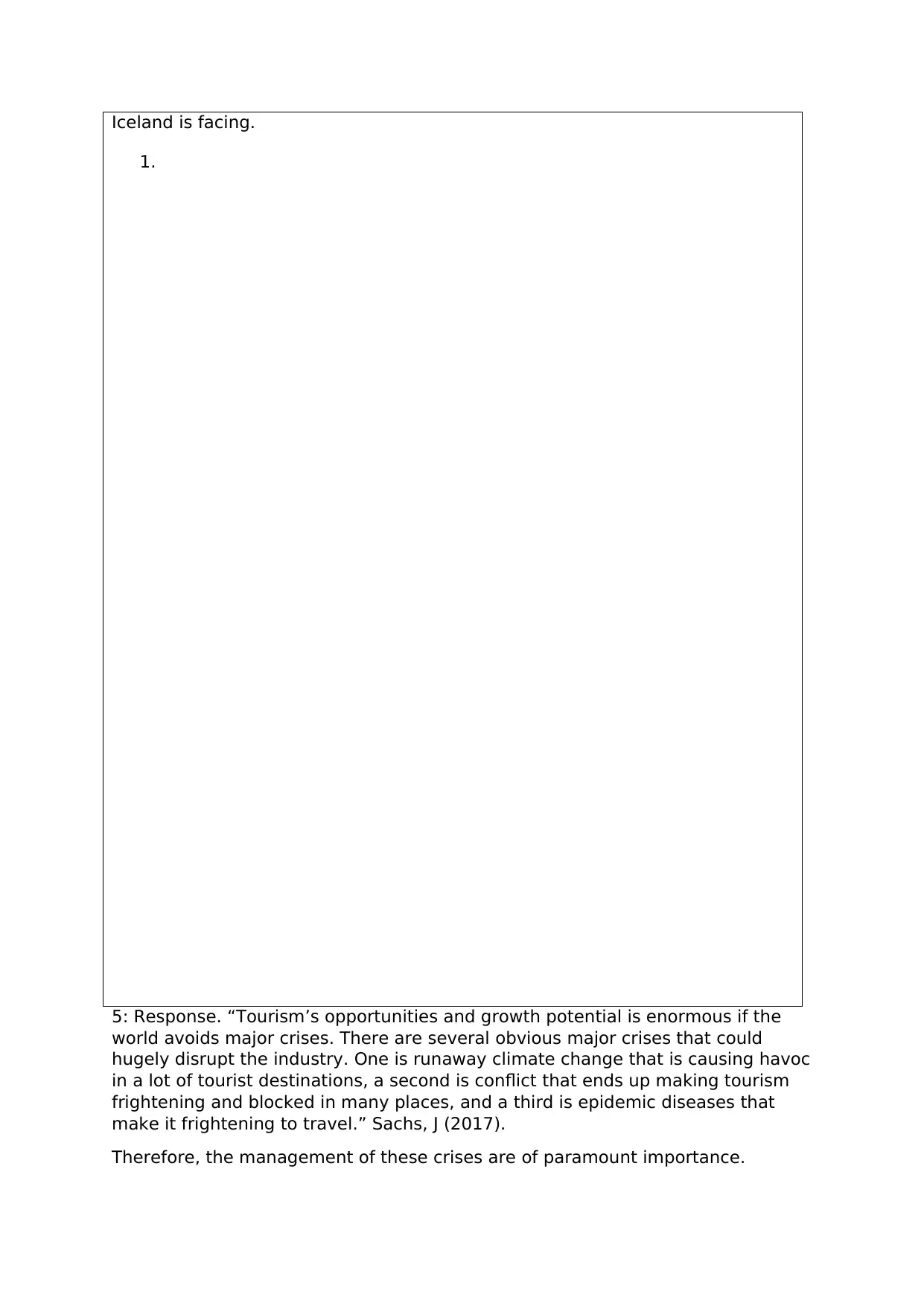
Iceland is facing.
1.
5: Response. “Tourism’s opportunities and growth potential is enormous if the
world avoids major crises. There are several obvious major crises that could
hugely disrupt the industry. One is runaway climate change that is causing havoc
in a lot of tourist destinations, a second is conflict that ends up making tourism
frightening and blocked in many places, and a third is epidemic diseases that
make it frightening to travel.” Sachs, J (2017).
Therefore, the management of these crises are of paramount importance.
1.
5: Response. “Tourism’s opportunities and growth potential is enormous if the
world avoids major crises. There are several obvious major crises that could
hugely disrupt the industry. One is runaway climate change that is causing havoc
in a lot of tourist destinations, a second is conflict that ends up making tourism
frightening and blocked in many places, and a third is epidemic diseases that
make it frightening to travel.” Sachs, J (2017).
Therefore, the management of these crises are of paramount importance.
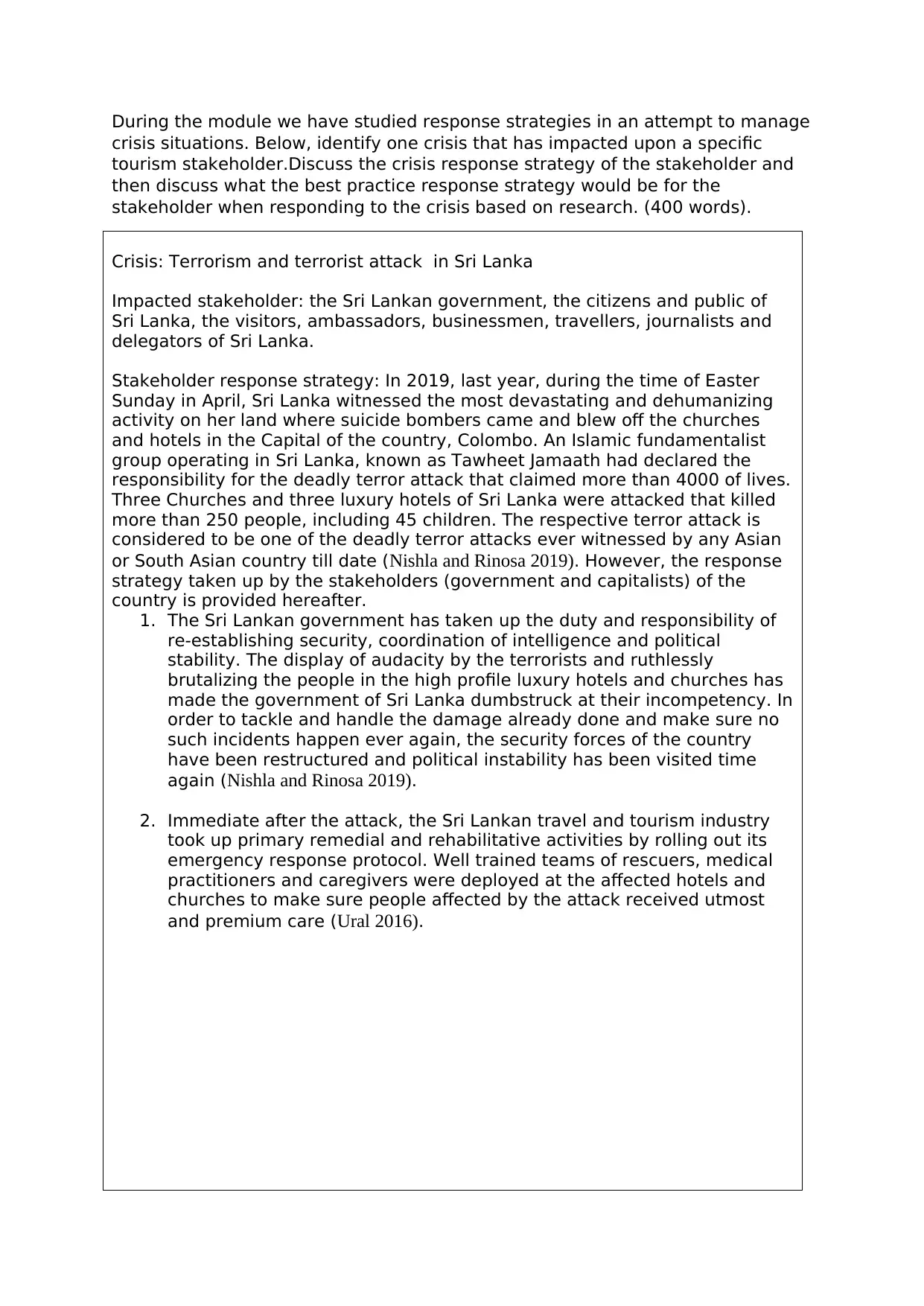
During the module we have studied response strategies in an attempt to manage
crisis situations. Below, identify one crisis that has impacted upon a specific
tourism stakeholder.Discuss the crisis response strategy of the stakeholder and
then discuss what the best practice response strategy would be for the
stakeholder when responding to the crisis based on research. (400 words).
Crisis: Terrorism and terrorist attack in Sri Lanka
Impacted stakeholder: the Sri Lankan government, the citizens and public of
Sri Lanka, the visitors, ambassadors, businessmen, travellers, journalists and
delegators of Sri Lanka.
Stakeholder response strategy: In 2019, last year, during the time of Easter
Sunday in April, Sri Lanka witnessed the most devastating and dehumanizing
activity on her land where suicide bombers came and blew off the churches
and hotels in the Capital of the country, Colombo. An Islamic fundamentalist
group operating in Sri Lanka, known as Tawheet Jamaath had declared the
responsibility for the deadly terror attack that claimed more than 4000 of lives.
Three Churches and three luxury hotels of Sri Lanka were attacked that killed
more than 250 people, including 45 children. The respective terror attack is
considered to be one of the deadly terror attacks ever witnessed by any Asian
or South Asian country till date (Nishla and Rinosa 2019). However, the response
strategy taken up by the stakeholders (government and capitalists) of the
country is provided hereafter.
1. The Sri Lankan government has taken up the duty and responsibility of
re-establishing security, coordination of intelligence and political
stability. The display of audacity by the terrorists and ruthlessly
brutalizing the people in the high profile luxury hotels and churches has
made the government of Sri Lanka dumbstruck at their incompetency. In
order to tackle and handle the damage already done and make sure no
such incidents happen ever again, the security forces of the country
have been restructured and political instability has been visited time
again (Nishla and Rinosa 2019).
2. Immediate after the attack, the Sri Lankan travel and tourism industry
took up primary remedial and rehabilitative activities by rolling out its
emergency response protocol. Well trained teams of rescuers, medical
practitioners and caregivers were deployed at the affected hotels and
churches to make sure people affected by the attack received utmost
and premium care (Ural 2016).
crisis situations. Below, identify one crisis that has impacted upon a specific
tourism stakeholder.Discuss the crisis response strategy of the stakeholder and
then discuss what the best practice response strategy would be for the
stakeholder when responding to the crisis based on research. (400 words).
Crisis: Terrorism and terrorist attack in Sri Lanka
Impacted stakeholder: the Sri Lankan government, the citizens and public of
Sri Lanka, the visitors, ambassadors, businessmen, travellers, journalists and
delegators of Sri Lanka.
Stakeholder response strategy: In 2019, last year, during the time of Easter
Sunday in April, Sri Lanka witnessed the most devastating and dehumanizing
activity on her land where suicide bombers came and blew off the churches
and hotels in the Capital of the country, Colombo. An Islamic fundamentalist
group operating in Sri Lanka, known as Tawheet Jamaath had declared the
responsibility for the deadly terror attack that claimed more than 4000 of lives.
Three Churches and three luxury hotels of Sri Lanka were attacked that killed
more than 250 people, including 45 children. The respective terror attack is
considered to be one of the deadly terror attacks ever witnessed by any Asian
or South Asian country till date (Nishla and Rinosa 2019). However, the response
strategy taken up by the stakeholders (government and capitalists) of the
country is provided hereafter.
1. The Sri Lankan government has taken up the duty and responsibility of
re-establishing security, coordination of intelligence and political
stability. The display of audacity by the terrorists and ruthlessly
brutalizing the people in the high profile luxury hotels and churches has
made the government of Sri Lanka dumbstruck at their incompetency. In
order to tackle and handle the damage already done and make sure no
such incidents happen ever again, the security forces of the country
have been restructured and political instability has been visited time
again (Nishla and Rinosa 2019).
2. Immediate after the attack, the Sri Lankan travel and tourism industry
took up primary remedial and rehabilitative activities by rolling out its
emergency response protocol. Well trained teams of rescuers, medical
practitioners and caregivers were deployed at the affected hotels and
churches to make sure people affected by the attack received utmost
and premium care (Ural 2016).
⊘ This is a preview!⊘
Do you want full access?
Subscribe today to unlock all pages.

Trusted by 1+ million students worldwide
1 out of 19
Related Documents
Your All-in-One AI-Powered Toolkit for Academic Success.
+13062052269
info@desklib.com
Available 24*7 on WhatsApp / Email
![[object Object]](/_next/static/media/star-bottom.7253800d.svg)
Unlock your academic potential
Copyright © 2020–2025 A2Z Services. All Rights Reserved. Developed and managed by ZUCOL.


